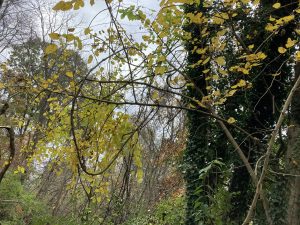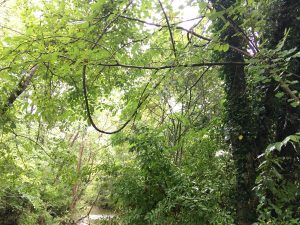I found myself acutely aware of the changes to the environment this time around. Since the animal activity in the area had dwindled, no longer demanding my attention, I was able to better focus on the changes that had been steadily progressing into the area. The trees, which had all but shed their vibrant array of leaves, were stark figures against the clouded sky. Their colors seemed deeper, richer, more luxurious. Evergreens in the distance stood proud as the only remnants of the lush forest that was here just a few weeks ago.
Yet now that the forest had become significantly sparse, I was surprised to see something I had never before noticed. Weakly poking between the bare branches was the view of a pasture. A pasture that was significantly closer to my location than I would have thought. Before the leaves had fallen from their branches, I assumed that the forest was rather dense, stretching far and wide as many Virginian forests do. However, it reminded me of the human influences in this area. My mind wandered to thoughts of what could have existed here before me, before the school, and even before this land was settled. But as I pondered on what used to be here, I noticed myself becoming aware of what still remained. The deep crevice to my north stood as a permanent scar in the landscape, formed from years of a roaring river washing the earth way. The densely packed trees surrounding me were not just a façade for a man-made pasture, but they were rather beautiful fragments of forest that once stood here. I entered my spot with a newfound awareness of my area, and by the end I left with a newfound respect.
The most drastic change with my followed objects was that the tree was surprisingly bare. The leaves that remained were yellowed, with bits of brown speckled around. The ground-covering that I was tracking is still puttering along, but its spread has been significantly decreased. Its leaves, which have been steadily becoming worse for wear, either have small holes in them or are duller than the rest. The last object of course was the spider’s web. The only change with this object was that ivy was started to encroach on it. I wonder if this will be the factor that brings the web down
The honeysuckle that I had identified last time is still as robust as before. It amazes me that it is able to devote energy towards producing fruit so late in the year. This is especially the case because there is less light present as we enter into winter. The mealybugs appeared to have slightly reduced numbers this time than they did last. I’m still amazed that I would have completely overlooked these tiny insects had I not been assigned to find peculiar features of my sit-spot area. Makes me wonder how many other things have gone completely unnoticed despite my attempts at watchfulness. The final object, though I still doubt the identification iNaturalist gave me, was the Lesser Periwinkle. I have mentioned it’s state in the prior paragraph, but I truly am surprised that such a hardy looking plant could produce such a delicate looking flower.
The specific spot that I chose to examine was a plot of dirt, or what I had originally assumed to just be dirt, to my immediate east. What it turned out to be actually was a myriad of cobble embedded within the earth. The stones wonderfully smoothed down as if weathered over time. I pulled a few from the ground and was surprised to see that their undersides were completely smoothed over as well. This made me wonder whether the rocks were artificially placed here or if they were remnants of a much higher stream. Amongst the fallen leaves that littered the ground were small, green shoots, varying in size and shape. Some had the distinctive leaf pattern of clover while others simply looked like delicate little stems. In this little plot of “dirt” was life. Life springing from the decaying litter. A beautiful dichotomy.



I really enjoyed your post Molly. It is interesting how winter lets us see the bones of a place – the hidden is uncovered! Well done!